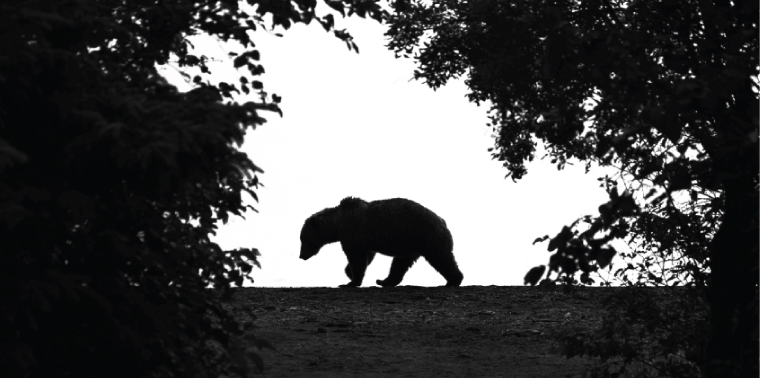June 3, 2013 — When Lewis and Clark set out in 1804 to map the American West, tens of thousands of grizzly bears roamed the northern plains and Rockies — a “large and a turrible looking animal, which we found verry hard to kill,” their journals record. But just decades later, killing grizzlies had become common, as the Wild West was settled and large animals were cleared to make room for ranching, mining and homesteading.
By 1975, there were only about 135 grizzlies left around Yellowstone and a few hundred more scattered throughout western states. The federal government moved to list the species under the Endangered Species Act, where it has, for the most part, been ever since.
Today, grizzlies have rebounded. With roughly 600 in the Greater Yellowstone Area, wildlife officials are ready to delist the species in that ecosystem and proclaim North America’s greatest conservation victory. “It’s taken us 30 years to get to this point,” says Chris Servheen, grizzly bear recovery coordinator for the U.S. Fish and Wildlife Service. “We consider the species recovered.”
But some say America should have more grizzlies — thousands more.
Similar debates swirl around the buffalo and the wolf. When it comes to wildlife conservation, the question of how many animals is enough is as much about philosophy as it is about biology. The answer depends on how wild we want our West — and other places — to be.
“Grizzlies are moving back into their historic ranges, so we’re seeing conflicts with humans. When you get conflicts, you get a push to control bears.” — Erin Edge, Defenders of Wildlife
Currently grizzlies are relegated to designated “recovery zones,” where state and federal officials carefully monitor their rates of reproduction and mortality and make sure they have enough food.
All this management makes the grizzlies of today “the very definition of an open-air zoo population,” according Chuck Neal, a retired ecologist for the U.S. Department of the Interior and author of Grizzlies in the Mist. To have a truly wild, free-ranging population, he argues, “we must permit these bears to expand their habitat.”
But the states surrounding Yellowstone — Montana, Wyoming and Idaho —want just the opposite. Citing threats to livestock and public safety, they want to confine the bears to designated areas and thereby limit their numbers. From 1986 to 2010, there were no fatal grizzly attacks on humans in Yellowstone. In the past three years, there have been four.
“Grizzlies are moving back into their historic ranges, so we’re seeing conflicts with humans,” says Erin Edge with Defenders of Wildlife, a national organization focused on conservation and the protection of biodiversity. “When you get conflicts, you get a push to control bears.”
Once federal protections are removed from an animal, management is turned over to the states. Wyoming is already lobbying to fast track the delisting process so the state can reintroduce hunting and thereby control its bear population. “There’s an essential urgency for the state of Wyoming to take care of nuisance bears,” says Steve Ferrell, policy advisor to Wyoming governor Matt Mead and former head of the state’s game and fish department.
But Neal says politics, including the deep pockets and influence of the livestock industry, are weighted too heavily in wildlife management decisions. “We’re talking about public land,” he says. “The preeminent use must be wildlife, not cattle.”
That is because wildlife is good for the land, he argues. In conservation biology, grizzlies are known as an “umbrella species.” Protecting grizzlies and other large animals in a given ecosystem indirectly protects smaller species whose habitat needs are not as great, thereby ensuring biodiversity, says Neal. “If you have habitat that can sustain a viable grizzly population, it can sustain a whole healthy ecosystem,” he says.
Grizzlies once roamed America from the Great Plains to the Pacific Ocean. They now occupy about 2 percent of their historic range, living in ecosystems that are geographically separate from one another. These are “isolated, postage-stamp sized populations,” says Louisa Willcox with Natural Resources Defense Council. If “linkage corridors” were created between these disparate ecosystems and grizzlies were allowed to occupy all the habitat that’s suitable for them, that would result in a population of roughly 3,000, Willcox says.
So far conservation groups are treading lightly in this debate. Many are still recovering from “a bruising battle over the wolf,” says Josh Mogerman with NRDC. For the first time in the history of the Endangered Species Act, an act of Congress removed a species — wolves in Montana and Idaho — from the list in 2011. “There’s a deep concern about setting up the same conflict dynamic,” says Mogerman, “which wouldn’t be good for the grizzly.”
Ensia shares solutions-focused stories free of charge through our online magazine and partner media. That means audiences around the world have ready access to stories that can — and do — help them shape a better future. If you value our work, please show your support today.
Yes, I'll support Ensia!

- “Currently grizzlies are relegated to designated “recovery zones…” - This is not true. In fact hundreds of grizzlies live parts of the year outside of recovery zones. We even have females denning and having cubs outside recovery zones. When the grizzly recovery zone in Yellowstone was delineated in 1982, the distribution of grizzlies in the Yellowstone ecosystem was entirely within the Recovery Zone of 23,833 sq. km (Schwartz et al. 2002. Distribution of grizzly bears in the Greater Yellowstone Ecosystem, 1990-2000. Ursus 13:203-212.). In 2004, the distribution had increased to 36,364 sq km. By 2010, grizzly distribution had continued to increase to 50,280 sq km, which is 2.1 times the distribution in 1982 (Bjornlie, D.D., D.J. Thompson, M.A. Haroldson, C.C. Schwartz, K.A. Gunther, S.L. Cain, D.B. Tyers, K.L. Frey, and B.C. Aber. In press. Methods to estimate distribution and range extent of grizzly bears in the Greater Yellowstone Ecosystem. Wildlife Society Bulletin 000:000-000.).
In the Northern Continental Divide Ecosystem (NCDE) in Northwest Montana where there are 1000 grizzlies increasing at 3% per year, significant numbers of bears live outside the recovery zone line. There are no state or federal policies to “confine the bears” within the recovery zones and the facts of their expanding distribution confirm that.
- “All this management makes the grizzlies of today “the very definition of an open-air zoo population,” according Chuck Neal, a retired ecologist for the U.S. Department of the Interior and author of Grizzlies in the Mist. To have a truly wild, free-ranging population, he argues, “we must permit these bears to expand their habitat.” – This is not true. The expanding distribution of bears (detailed above) shows this statement has no basis in fact. This statement reduces the credibility of the article and of your publication.
- “But the states surrounding Yellowstone — Montana, Wyoming and Idaho —want just the opposite. Citing threats to livestock and public safety, they want to confine the bears to designated areas and thereby limit their numbers.“ – This is not true. In fact the states have been active partners in the recovery and EXPANSION in range and numbers of grizzly populations for 32 years. The states annually contribute hundreds of thousands of dollars and skilled management and research personnel toward conservation, management, education, outreach, and monitoring efforts and will continue to do so after delisting. We do have to manage bears when they get into conflicts on private lands but there is not a policy to “confine” bears anywhere. Hundreds of grizzlies live parts of their lives on private land with the support of the landowners, many of whom are cattle ranchers. Only a small percentage of grizzly bears every kill any cattle. The majority of grizzlies live in and among cattle with few conflicts. Management after delisting will not look much different than what occurs now under listed status and if hunting occurs it will be limited in scope all hunting mortalities will be carefully managed within sustainable limits so that hunting will never threaten grizzly populations (see the post-delisting management plans at: http://www.fws.gov/mountain-prairie/species/mammals/grizzly/continentalindex.html and
http://www.fws.gov/mountain-prairie/species/mammals/grizzly/Final_Conservation_Strategy.pdf).
- “These are “isolated, postage-stamp sized populations,” says Louisa Willcox with Natural Resources Defense Council. If “linkage corridors” were created between these disparate ecosystems and grizzlies were allowed to occupy all the habitat that’s suitable for them, that would result in a population of roughly 3,000, Willcox says. – In fact, an active linkage zone effort has been underway for more than a decade to identify and manage the areas between the large blocks of public land in the Northern Rockies (including adjacent areas in British Columbia) so that grizzlies and other wildlife species can move between these areas. Grizzlies have already moved between some of these areas and have gotten half way between the NCDE and Yellowstone. It is just a matter of time until the NCDE and Yellowstone are genetically connected with males moving between these ecosystems. As to the statement: “…that would result in a population of roughly 3,000, Willcox says”, what is the scientific basis for that number?